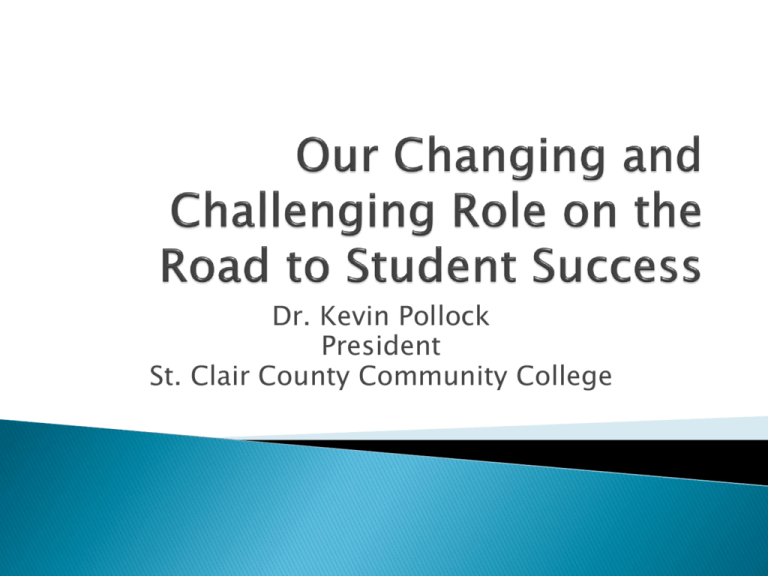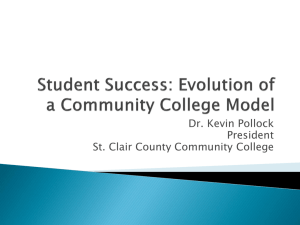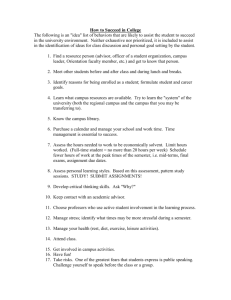
Dr. Kevin Pollock
President
St. Clair County Community College
Response to outside
“drivers” (federal, state,
community);
Internal “drivers” (staff,
students, faculty);
Institutional change
and its challenges;
Accountability issues;
Academic mobility;
Our role in retention
and student success;
Redefining our role?
Utilizes main
ingredients that
compliment each other
Allows room for
seasonings to taste
Has a desired end
result
Were the Gatekeepers;
Were told how many
students we needed
to enroll;
Were told to fix and
maintain transfer
guides we couldn’t
control;
Be in charge of
“enrollment
management”,
whatever that meant.
Major student
advocates
The ones who saw
gaps and problems
but didn’t really have
a big enough voice;
Keepers of obvious
knowledge that others
didn’t want to hear
Down-to-Earth
Common Sense
Chronic
versus
(and) Crisis
Situations
What is our past?
What is our future?
What happened to
common sense?
Where do we fall in
all of this?
How does this
affect us and our
evolving role?
National Issues
◦ P-20 Concept
◦ U.S. Dept. of Ed Action Plan for Improving Measures of
Postsecondary Student Success (Obama Initiative)
◦ AACC Completion Agenda
State Issues
The “Basics” of Enrollment Management: create a
plan, work with faculty, increase retention,
connect students to the campus, etc.
A lot of information available based on “fouryear” models; tougher for “two-year” colleges
What does this mean for us?
Let’s take it step by step
1.
2.
3.
4.
5.
6.
7.
8.
9.
10.
The “Open Door” and its ramifications;
Needs of nontraditional students;
Needs of the employed student;
Accountability;
The opportunities and attainment gap;
Remediation and basic skills;
Transfer and articulation;
Noncredit and workforce development;
Financial aid;
Supportive learning environments.
“Four out of every ten college students are parttime”
“Seventy-five percent of today’s students are
juggling some combination of families, jobs, and
school while commuting to class”
“Only one quarter go full-time, attend residential
colleges, and have most of their bills paid by their
parents”
“Part-time students rarely graduate; only a quarter
ever make it to graduation day”
“Students are taking too many credits and take too
much time to graduate”
“Remediation is broken, producing few students
who ultimately graduate”
Startling statistics:
Time is the Enemy
Complete College America
Copyright © 2011 Complete College America. All rights reserved.
Copyright © 2011 Complete College America. All rights reserved.
Copyright © 2011 Complete College America. All rights reserved.
Copyright © 2011 Complete College America. All rights reserved.
FALL SEMESTER CAMPUS UPDATE
Accountability – Coming Attractions:
Voluntary Framework of Accountability
College Readiness Measures
Report of % of students referred to developmental education (DE) who:
-attempt first math or English/reading DE course;
-complete highest level math/English/reading DE course;
-complete first college-level course in math/English/reading
-complete all DE courses
Progress Measures
Report of % of students who:
-successfully complete in term one;
-reach credit threshold by end of year two
-are retained from fall of term one to next academic term;
-who reach year two outcomes;
-who successfully complete at end of year two
St. Clair County Community College
September 9, 2011
FALL SEMESTER CAMPUS UPDATE
Accountability – Coming Attractions:
Voluntary Framework of Accountability
Outcomes and Success Measures
Report on students who:
-earn an associate’s degree – without transfer and with transfer;
-who earn a certificate – without transfer and with transfer;
-who transfer to a 4-year with no degree or certificate;
-who laterally transfer.
St. Clair County Community College
September 9, 2011
Pennsylvania
community colleges
have become the
first statewide
system in the
country to adopt the
Voluntary
Framework of
Accountability
created by the
American
Association of
Community
Colleges.
FALL SEMESTER CAMPUS UPDATE
Accountability – Coming Attractions
National Community College Benchmark Project
12 Colleges in Michigan currently reporting on 130 metrics including the
following
Student and Student Outcomes
-Fall to Spring and Fall to Fall persistence rates
-Educational goal attainment
-Institution-wide grade information
-Developmental course retention and success rates
Institutional Effectiveness
-Average credit section size
-Student/faculty ratio
-Instructional faculty load
-Cost per credit hour and FTE student
Community and Workforce Development
-Market penetration rates
-Business and industry productivity
St. Clair County Community College
September 9, 2011
Outcome measures
◦ Degrees awarded annually (number and change
over time)
◦ Graduation rates
◦ Transfer rates
Progress measures
◦
◦
◦
◦
◦
◦
Remediation (entry and success)
Success in first-year math and English
Credit accumulation
Retention rates
Course completion
Time and credits to degree
In
God
we trust,
all others
bring
data.
Indiana’s State
Commission for
Higher Education’s
goals
Double the number of
graduates by 2025
Increase on-time grad
rates to at least 50%
at four-year schools
and 25% at two-year
schools by 2018.
Community College Week April 2,
2012
Governor proposal
on degrees in STEM
Senate proposal
based on contact
hours, local strategic
value, administrative
costs, 4 of 5 goals
certified by board
House proposal
helps pay down
retirement
Block transfer
Reverse transfer
Virtual Learning
Mandated Transfer
Network (Michigan)
Funding problems
Governmental
intervention (or insert
your own word) local,
state, feds
Who gets credit for a
graduate?
We are in the middle;
We are hearing things
we have been saying
for years;
We are experts in
many ways;
We need to inform our
co-workers why these
issues are important
and how this affects
them
We need to adjust
what we do as well as
take a stronger
leadership role
One-third of all students transferred at
least once within five years;
Most prevalent destination was public twoyear institutions;
Most common time of first transfer was in
the student’s second year;
Transfer rates were similar for part- and
full-time students;
Over one quarter of all transfers crossed
state lines.
Transfer & Mobility: A National View of Pre-Degree Student Movement in
Postsecondary Institutions (National Student Clearinghouse Research Center)
February, 2012
More data
A greater focus on students and their success
Less funding
More rules
Questions like, “Who gets credit for graduates”?
Transfer issues
What can we do about all of this?
Does this mean change?
We are in the middle. Sometimes we feel like
this…
“Students
Finish What
They Start”
Tallahassee
Community College
Student
Access to
Student
Success
What roles could
change?
What affect does
this have on staff?
What will you do
about it?
Why would we want
to change?
Financial situation
Reorganization
Expansion
New opportunities
New challenges
Better service to
students?
◦ We are being forced
to do it.
◦
◦
◦
◦
◦
◦
For students
For the college
For the staff
How can you cut
through the red
tape?
Resistance to
change
Power
issues/governance
issues/multi-unit
systems issues
Project mentality
Institutional silos
Lack of stakeholder
involvement (and
accountability)
Lack of
institutional
research capacity
Aversion to data
Unreliable data
Lots of data but
nobody actually
using it
(Should IR be in
Student Services?)
Absence of
strategic planning
(…that anyone
uses)
Overload, “initiative
fatigue.”
competing or
unclear priorities
Failure of focus
Reluctance to
reallocate
Lack of governing board awareness/support
Inappropriate governing board involvement
Legislative mandates
Conflicting state policies
FALL SEMESTER CAMPUS UPDATE
Progress is a nice word. But change
is its motivator. And change has its
enemies.
~Robert Kennedy
St. Clair County Community College
September 9, 2011
“…It does not take genius.
It takes diligence.
It takes moral clarity.
It takes ingenuity.
And above all, it takes a willingness to try.”
Atul Gawande, Better: A Surgeon’s Note on Performance
Finances
Transformation
questions: process
changes, type of
building, what do we
value, etc.
People and staff
◦
◦
◦
◦
Always did it this way
We can’t work together
It’s not my job
Simple difficulty of
handling change STRESS!
Change is
good…
You go first!
FALL SEMESTER CAMPUS UPDATE
One-fifth of the people are against
everything all of the time.
~Robert Kennedy
St. Clair County Community College
September 9, 2011
“Do
the right
thing for the
right reason
and when in
doubt, lean
toward the
student”
Take the lead
Stand up and speak
Utilize data;
Keep the focus on
student success;
Realize you have to
help others
understand what
student success is all
about;
Ask, “who can we
help”?
Classes that don’t
transfer
Dual enrollment
credits that don’t
transfer
Programs that don’t
align so students
transfer before
completing a degree
Transcript issues –
should they be
standardized?
UIC – Unique
Identification Codes
Portability
How agreements are
maintained
Direct credit issues
Clean agreements
Seamless transfers
Advising issues
Understand SEM (or student success)
What is the potential for your campus?
Define the reasons for pursuing student
success?
What are the issues?
Is the rationale cogent and clear?
What are we facing: high school decline,
student satisfaction, large retention issues,
financial?
Define a role in transfer issues (president to
president)
Recruiting?
Advising?
Mentoring?
Attending programs?
Learning outcomes and assessment of classes and
programs?
Developmental Education?
Working with K-12?
A student friendly class schedule?
Working with peer faculty from other institutions on
transfer agreements
Program Review
Accountability
What else?
Every course,
every program,
every college is
perfectly
designed to
get the results
it is currently
getting.
We
can’t
get better
at what
we’re not
willing to
look at.
“Take nothing on its
looks; take
everything on
evidence. There’s
no better rule.”
Charles Dickens (1812-1870)
◦ - Great Expectations
How is our customer
service?
How well do our
students get through
our maze?
Are we looking at all the
things that affect
students?
How well do we work
with our partners?
How well do we work
with our colleagues?
Are we trying to be
great at what we do?
“Some
folks
make you feel
at home, while
others make
you wish you
were there”
Have a winning attitude
Make a commitment to the customer
Use proper grammar and enunciate
Work on oral communication skills
Increase your phone ability
Develop stronger listening skills
Use different problem-solving techniques
Have the confidence to deal with difficult
customers
Manage job stress
Exceed customer expectations
Recruitment
Application
Admission
Orientation (mandatory?)
Testing and course
placement
Scheduling
Registration
Bill payment
Book purchases
Advising
Financial aid
Mentoring
Online issues
Examine course availability
Correct course placement
Do courses “line up”?
Ask yourself honestly, “Is the schedule done
in the best interest of the students or the
faculty”?
Identify high risk courses
Identify killer combinations of courses and
ask why we allow students to take them
Create and enforce a campus attendance
policy
Advising – the volume of students, bad advice
Do you track success through data and
interviews?
Do you have a student success class?
◦ One or three hours long?
◦ Required or not?
Time management issues
◦ Related to study time
◦ Related to family time
May have difficulty in assessing the value of an
education;
May regard public education as a form of
entitlement rather than a good or service;
May not have as much of a choice in public
education compared to most goods and
services;
May lack access to third-party ratings of public
education services;
May not realize that the burden of success lies
with them;
May not recognize that classmates can affect
their individual level of benefit.
Learning the norms of campus culture
Finding a niche
Putting down roots
Transferring successful behaviors from other
settings
Developing focus
Resisting peer pressures
Compartmentalizing family and work pressures
Exhibiting classroom habits of successful students
Building relationships with teachers
Asking for help
Levitz, R. S., Noel, L., & Richter, B. J. (1999). Strategic moves for
retention success. New Directions for Higher Education (108), 3149.
K-12
Two-Year or FourYear Institutions
Community
Businesses
Faculty
Staff
STUDENTS!
Create a culture of responsibility, high
standards, and clear expectations;
Provide a deep and broad array of student
support services;
When in doubt lean in the direction of the
student;
Recognize that students are much more than
customers, but recognize that they are also
customers;
Create a student processes taskforce.
Use data to help, not
to hurt
Have a passion for
your work
Be tenacious
Stay Strong
Be supportive
Take a more active role in the direction of the
institution
Use data
Be a team
Work in harmony
Listen to what is going on around you
We can all be right separately but wrong
together
Remind everybody that it is all about the
students
810-989-5545
kapollock@sc4.edu





